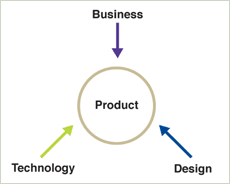I recently put together a personal retrospective that outlines some of the high-level principles I’ve come to embrace through nine years of interface design. I described these principles as “lessons” to focus on how I came to adopt these principles and why. Lessons are a useful way to think about interface design methodologies and guidelines because not only is the design process complex, it also never really ends.
“We now accept the fact that learning is a lifelong process of keeping abreast of change. And the most pressing task is to teach people how to learn.” — Peter F. Drucker
 When designing digital products -technology, business, and user experience need to converge in all the right ways lest one of these factors overpower the others. If the technology is not up to par, people can’t use the product. If the business case is not valid, people don’t want to use the product. And if the user experience comes up short, people don’t know how to use the product.
When designing digital products -technology, business, and user experience need to converge in all the right ways lest one of these factors overpower the others. If the technology is not up to par, people can’t use the product. If the business case is not valid, people don’t want to use the product. And if the user experience comes up short, people don’t know how to use the product.
Experience builds a designer’s ability to understand how these factors limit and enhance each other. It helps to build a designer’s horizontal skill sets. Tim Brown at IDEO described this horizontal skill set as the top of a “T”:
“[T-shaped people] have a principal skill that describes the vertical leg of the T -they're mechanical engineers or industrial designers. But they are so empathetic that they can branch out into other skills, such as anthropology, and do them as well. They are able to explore insights from many different perspectives and recognize patterns of behavior...” –Strategy by Design
I’ve found that the best way to lengthen the “top of the T” is through interactions with cross-disciplinary teams and experience with products in multiple domains. Each experience is a set of lessons that begin to converge as patterns over time which in turn become one’s skill set. As a result, I’ve always approached design as a learning experience rather than a production process of applying guidelines and set processes.
The market, our customers, and the medium in which we design are always teaching us new things. As these factors change, design needs to change with them. We need to keep learning about how our products are being used, abused, or discarded and we need to feed those lessons back into our designs.
Over the next few articles on Functioning Form, I’ll dive into each of these lessons with concrete examples and explanations:
- Insights come in all shapes and sizes.
- Writing it down forces you to think it through.
- Less is more…
- …except when more is more.
- Patterns occur at all levels.
- Documentation takes time. Make it worth the effort.
- Design is communication. Use it as such.
- It’s about more than users.
- Design is never done.